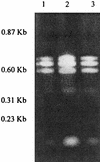Identification of Salmonella typhimurium genes required for colonization of the chicken alimentary tract and for virulence in newly hatched chicks
- PMID: 9573095
- PMCID: PMC108169
- DOI: 10.1128/IAI.66.5.2099-2106.1998
Identification of Salmonella typhimurium genes required for colonization of the chicken alimentary tract and for virulence in newly hatched chicks
Abstract
From a collection of 2,800 Tn5-TC1 transposon mutants of Salmonella typhimurium F98, 18 that showed reduced intestinal colonization of 3-week-old chicks were identified. The sites of transposon insertion were determined for most of the mutants and included insertions in the lipopolysaccharide biosynthesis genes rfaK, rfaY, rfbK, and rfbB and the genes dksA, clpB, hupA, and sipC. In addition, identification was made of an insertion into a novel gene that encodes a protein showing similarity to the IIC component of the mannose class of phosphoenolpyruvate-carbohydrate phosphotransferase systems, which we putatively called ptsC. Transduction of most of the transposon mutations to a fresh S. typhimurium F98 genetic background and construction of defined mutations in the rfbK, dksA, hupA, sipC, and ptsC genes of S. typhimurium F98 supported the role in colonization of all but the pts locus. The virulence of the rfbK, dksA, hupA, sipC, and ptsC defined mutants and clpB and rfaY transductants in 1-day-old chicks was tested. All but the ptsC and rfaY mutants were attenuated for virulence. A number of other phenotypes associated with some of the mutations are described.
Figures



References
-
- Barrow P A, Huggins M B, Simpson J M, Lovell M A. Observations on the pathogenesis of Salmonella typhimurium infection in chickens. Res Vet Sci. 1987;42:194–199. - PubMed
-
- Barrow P A, Simpson J M, Lovell M A. Intestinal colonisation in the chicken by food-poisoning Salmonella serotypes; microbial characteristics associated with faecal excretion. Avian Pathol. 1988;17:571–588. - PubMed
Publication types
MeSH terms
Substances
LinkOut - more resources
Full Text Sources
Other Literature Sources
Molecular Biology Databases

